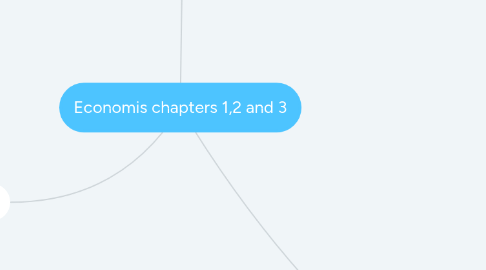
1. chapter 3
1.1. We studied the economics model of scarcity (lack of something), a choice and opportunity cost that helps us to understand the choices that people and societies make.
1.2. We learn the central idea of economics: efficiency that is ability of something
1.3. We learn what makes our production possibilities expand and how we gain by specializing and trading with each other.
1.4. 3.1
1.4.1. Production possibilities frontier diving line of (something you can use) goods and (something someone does for you) services and things that cannot be produced.
1.4.2. Production efficiency A situation were we cannot make more of a good and service without producing less of something else.
1.4.3. Tradeoff An exchange, give up on something to get something better or worst
1.4.4. Free lunch A gift, getting something without giving up something else
1.5. 3.2
1.5.1. Opportunity Cost: What a person sacrifice when they choose one option over another.
1.6. 3.3
1.6.1. Using resources correctly Allocative efficiency People value a lot the amount of production of the goods and services but we must give up another good.
1.7. 3.4
1.7.1. Economic growth The supported expansion of creation of opportunities.
1.8. 3.5
1.8.1. specialization and Trade Comparative advantage The potential of a person to do an activity or produce a good or service at a lower situation than someone else.
1.8.1.1. Absolute advantage When a person do more things and takes advantages of several or all the activities.
2. chapter 1
2.1. Economics studies the choices that we do as we control with the things we want to satisfy.
2.1.1. 3 questions that will make easier for us to make choices, and good and services get well produce
2.1.1.1. What?
2.1.1.2. How?
2.1.1.3. For Whom?
2.1.2. Self Interest
2.1.2.1. best choices for one person
2.1.3. social choice
2.1.3.1. best choices for many persons
2.1.4. Does a “self choice” affects social interest?
2.1.4.1. Globalization and international outstanding
2.1.4.2. The new economy
2.1.4.3. Disappearing tropical rainforest
2.1.4.4. Global warming
2.1.4.5. Natural disaster
2.1.4.6. Unemployment
2.1.4.7. A social security time bomb
2.1.5. 1.2
2.1.5.1. Rational choice: a choice that uses the resources to achieve the goal of the person making that choice.
2.1.5.2. Opportunity cost: is giving your best to get what you want. Your efforts sunk cost: something you can’t change, can’t be reversible.
2.1.5.3. Benefit: gain of pleasure. You like what you receive.
2.1.5.4. Margin: is the choice tu made by comparing all the important alternatives systematically and incrementally.
2.1.5.4.1. Marginal cost: the opportunity cost that grows up from 1 unit an an activity. What you must give up to get extra unit of it.
2.1.5.4.2. Marginal benefit: something is measured by it are willing to give up to get additions unit of it.
2.1.5.5. Incentive: is a reward
2.1.5.6. Microeconomics: study of choices that individuals and businesses make and the way these choices interact and are influenced by governments. Macroeconomics: study of the total effects on the national economy and the global economy is the choices that individuals, businesses, and government make.
2.1.5.7. Ceteris paribus: it means that other things remain the same.
2.1.5.8. Correlation: 2 things moving on 1.
3. chapter 2
3.1. 2.1 What, How and For Whom?
3.1.1. WHAT/Consumption goods and services: good and services used to provide personal enjoyment. Capital goods: goods bought by businesses to increase their productive resources. Government goods and services: goods and services that are bought by governments. Export goods and services: goods and services that are produced in one country and sold in other countries.
3.1.2. HOW/Factors of production: productive resources that are used to produce goods and services.
3.1.3. Land: the “gifts of nature” or natural resources.
3.1.4. Labor: work time and work effort that people give to produce goods and services. Human skill = Human capital
3.1.5. Capital: tools, instruments, machines, buildings, and other items that were produced and businesses now use them to produce goods and services.
3.1.6. Entrepreneurship: human resource that organizes labor, land and capital.
3.1.7. FOR WHOM/Who gets the goods and services that are produced depends on the incomes that people earn and the goods and services that they choose to buy. Rent: income paid for the use of land. Wages: income paid for the services of labor. Interest: income paid for the use of capital. Profit (or loss): income earned by an entrepreneur for running a business. Functional distribution of income: distribution of income among the factors of production. Personal distribution of income: distribution of income among households.
3.2. 2.2 The Circular Flows
3.2.1. Circular flow model: a model of economy that shows the circular flow of expenditures and income that results from decision makers’ choices and the way those choices interact to determine what, how, and for whom goods and services are produced.
3.2.2. Households: individuals or groups of people living together.
3.2.3. Firms: the institutions that organize the production of goods and services.
3.2.4. Market: any arrangement that brings buyers and sellers together and enables them to get information and do business with each other.
3.2.5. Goods markets: markets in which goods and services are bought and sold.
3.2.6. Factor markets: markets in which factors of production are bought and sold.
3.2.7. National Debt: the total amount that the federal government has borrowed to make expenditures that exceed tax revenue to run a government budget deficit.
3.3. 2.3 The Global Economy:
3.3.1. Energy: land is the key resource for producing energy, and the location of oil, natural gas, and coal determines the sources of the world's energy. These resources are distributed unevenly across the globe.
3.3.2. Food: agriculture is a more larger part of the developing economies. Despite these large differences in the importance of agriculture, the advanced economies produce about one-third of the world's food.
3.3.3. International distribution: much of the greater inequality at the global level arises from differences in average incomes among countries.

